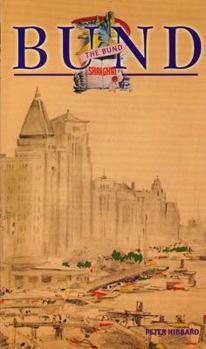The Bund Shanghai: China Faces West
(Part of the Odyssey Guides Series)
This book tells the story of the making of the Bund: from its beginnings as a muddy foreshore and its conversion into a fine esplanade in the latter half of the 19th century, when its infamous "Public... This description may be from another edition of this product.
Format:Paperback
Language:English
ISBN:9622177727
ISBN13:9789622177727
Release Date:April 2007
Publisher:Odyssey Publications
Length:368 Pages
Weight:1.60 lbs.
Dimensions:0.8" x 5.3" x 8.5"
Customer Reviews
3 ratings
Finally, the Bund's Buildings Explained
Published by Thriftbooks.com User , 16 years ago
I was excited to find a copy of Hibbard's The Bund in the Shanghai Museum gift shop. It's about time we had a good history of these beautiful, architectural masterpieces! When people arrive in Shanghai, one of the first places on their sight-seeing list is usually the "Bund." As people wander down this fabled road, enjoying the architecture and scenery, few know the names of these lovely facades or the often interesting history behind them. And even many of us who live here have had to stop and ponder, what exactly is a "bund"? "Bund" is not a German word, as is often thought, but is of Hindustani origin. The word means an artificial causeway or embankment. Shanghai's bund began its development in the 1850s. By the 1860s, Shanghai actually had four bunds. These four roads, or "Wai Tan" ("outer shore" in Chinese), demarcated the sides of the British settlement--which served as the center of foreign life in the city. Now days the city is down to only one "Bund" road, which was officially named Zhongshan Road Number One (east) in 1945. This legendary causeway has been one of the city's most modern areas for much of its recent history, showcasing the latest architectural designs and taking tourists who were expecting charming pagodas by surprise. The Bund's builders have traditionally competed to dazzle onlookers by erecting the most progressive and impressive designs. In more recent times, the area has faced major challenges as developers have sought to restore the area to its former glory--or dare I suggest surpass! Concerns have surfaced and debates have been fueled over historical conservation and restoration of the Bund. Many people ponder the riverside's future, as would-be developers attempt to surmount the difficulties of finding money and support as they seek to restore and preserve this prestigious set of addresses. Get the inside scoop on all 29 Bund establishments in local tour director Peter Hibbard's new book The Bund. Within its pages, Hibbard provides a well-researched history and timeline of the Bund's development and each of its buildings. The book includes many featured essays, old documents, and letters written about the Wai Tan. The numerous photos and fun old maps complete Hibbard's well done attempt to bring the Bund's story to life. Truly hard core Bund fans can keep current by visiting Hibbard's Bund website, gingergriffin.com At the book's end, readers can supplement their Bund knowledge with a helpful directory of the buildings and their occupants, including phone numbers. The finale also features a chart of the buildings' occupants, then and now, a walking tour complete with maps, and an index. The book is a must if you find yourself playing tour guide to out-of-town visitors who you want to impress with insider knowledge, or if you are simply interested in this fascinating area of the city. It should also please architecture buffs.
A splendid guide and history
Published by Thriftbooks.com User , 16 years ago
The Bund - Shanghai's famous half-mile avenue along the Huangpu River - contains a line of fabulous monumental structures from Shanghai's dazzling colonial life of the 1920s and '30s. Despite the Western styles of architecture, the Bund is very much a part of China's history, with all that is good and bad. Peter Hibbard's book tells the richly populated story of the Bund's development from the late 1800s, when Shanghai was the West's gateway into China near the mouth of the Yangtze River. Capital investment flooded into the area (much as it is doing today). The merchant banking and trading houses went up in grand style - neo-Gothic, classic European, Art Deco - using enormous quantities of often expensive materials from China, Europe and America. And a wildly extravagant social life blossomed, with balls, festivals and big-name entertainers from the West. Though the Chinese, from professionals to day laborers, found thousands of jobs there, under the earlier international treaties they had no legal authority. Hibbard notes the ill-use and neglect of many of the buildings after the Japanese occupation, the post-war Communist takeover and the flight of the Westerners. While most of the structures have been renovated - some beautifully - and are partially occupied by banks, stylish restaurants and fashion houses, their future is uncertain, he says. The Bund, with its grand buildings and its setting along the river, waits for Shanghai to make it part of its future as well as its tumultuous past. Hibbard is perhaps the leading authority on the Bund. He has stocked his book with the people, the plans and the external events that shaped its development. The text is wonderfully written and the pages are illustrated with hundreds of historical photos, drawings and poster art and with photographs of the present day. It's a guidebook and history as well as a book of stories to treasure.
a must have
Published by Thriftbooks.com User , 16 years ago
A must have guide if going to Shanghai. Read it before going, take it with you, then read it again. Made the City come alive with its history.




